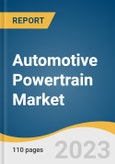The global automotive powertrain market size is expected to reach USD 2446.74 billion by 2030 registering a CAGR of 15.8%. The increasing demand for environment-friendly vehicles and increasingly stringent government regulations regarding vehicular emission are expected to favor the demand for automotive powertrains in the market. Moreover, technological advancements in powertrain systems to enhance the vehicle's efficiency are anticipated to boost market growth prospects over the forecast period.
The adoption rate and pace of evolution of automotive powertrain vary across regions according to purchase subsidies, regulatory differences, road pricing, fuel taxation policy, state support, and consumer preferences. In Europe and countries such as China, South Korea, and Japan, stringent regulations are expected to make OEMs shift their focus on electrified powertrain options. Other significant factors that constitute the evolution of powertrain include developing charging infrastructure in different regions globally.
Increasing vehicle sales and the growing adoption of automated transmission vehicles in emerging countries such as India, China, Indonesia, Japan, and Brazil, are expected to drive the market. The substantial rise in the purchasing power of consumers has increased the demand for state-of-the-art motor vehicles, driving the demand for upgraded systems. The rising use of All Wheel Drive in SUVs in emerging regions is also expected to support the growth of the powertrain market. The growing demand for AWD-equipped vehicles in the Asia Pacific region is expected to boost the growth of the all-wheel-drive system market.
The COVID-19 pandemic has hampered the growth prospects of several industries in 2020; powertrain manufacturers are facing a year-on-year decline in unit volumes sales and revenues. For instance, BorgWarner Inc., a prominent market player in the electric powertrain market, witnessed a decrease in the e-Propulsion & Drivetrain business segment. However, the demand for vehicles with upgraded safety features is likely to increase post-pandemic. Since automotive powertrain plays a vital role in automobiles, the market could regain momentum. Furthermore, despite the pandemic, the growing demand for electric vehicles is anticipated to boost the demand for automotive powertrains.
The adoption rate and pace of evolution of automotive powertrain vary across regions according to purchase subsidies, regulatory differences, road pricing, fuel taxation policy, state support, and consumer preferences. In Europe and countries such as China, South Korea, and Japan, stringent regulations are expected to make OEMs shift their focus on electrified powertrain options. Other significant factors that constitute the evolution of powertrain include developing charging infrastructure in different regions globally.
Increasing vehicle sales and the growing adoption of automated transmission vehicles in emerging countries such as India, China, Indonesia, Japan, and Brazil, are expected to drive the market. The substantial rise in the purchasing power of consumers has increased the demand for state-of-the-art motor vehicles, driving the demand for upgraded systems. The rising use of All Wheel Drive in SUVs in emerging regions is also expected to support the growth of the powertrain market. The growing demand for AWD-equipped vehicles in the Asia Pacific region is expected to boost the growth of the all-wheel-drive system market.
The COVID-19 pandemic has hampered the growth prospects of several industries in 2020; powertrain manufacturers are facing a year-on-year decline in unit volumes sales and revenues. For instance, BorgWarner Inc., a prominent market player in the electric powertrain market, witnessed a decrease in the e-Propulsion & Drivetrain business segment. However, the demand for vehicles with upgraded safety features is likely to increase post-pandemic. Since automotive powertrain plays a vital role in automobiles, the market could regain momentum. Furthermore, despite the pandemic, the growing demand for electric vehicles is anticipated to boost the demand for automotive powertrains.
Automotive Powertrain Market Report Highlights
- In terms of vehicle type, the commercial vehicle segment is estimated to register the highest CAGR of 17.0% over the forecast period, owing to the increasing demand for a unified supply chain network connecting multiple transportation modes, including freight rail, air, express delivery services, maritime transport, and truck transport.
- In terms of propulsion type, the internal combustion engine (ICE) segment accounted for the largest share of 87.7% in 2022. The ICE segment consists of gasoline, diesel, and natural gas vehicles. Currently, gasoline engines are widely adopted and are projected to be replaced by diesel engines owing to the increasing difference between diesel and gasoline prices.
- Asia Pacific accounted for the largest market share of 61.6% in 2022. Home to the largest automobile manufacturing nations and markets, such as India, China, and Japan. The growth in the Asia Pacific region is mainly attributed to rising disposable income, increasing urbanization, and a highly competitive market that favors car ownership across the region.
Table of Contents
Chapter 1. Methodology and Scope
Chapter 2. Executive Summary
Chapter 3. Automotive Powertrain Market Variables, Trends & Scope
Chapter 4. Automotive Powertrain Market: Propulsion Type Estimates & Trend Analysis
Chapter 5. Automotive Powertrain Market: Vehicle Type Estimates & Trend Analysis
Chapter 6. Automotive Powertrain Market: Regional Estimates & Trend Analysis
Chapter 7. Competitive Landscape
List of Tables
List of Figures
Companies Mentioned
- BorgWarner Inc.
- Continental AG
- Magna International Inc.
- Marelli Holdings Co., Ltd.
- Mitsubishi Electric Corporation
- NIDEC CORPORATION
- Robert Bosch GmbH
- Schaeffler AG
- ZF Friedrichshafen AG
- VALEO
Methodology

LOADING...








